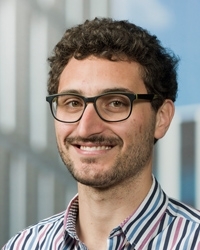
I am an experimental physicist working in nanophotonics problems.
Currently I am studying light-matter interactions at the nanoscale, specifically the interaction between single-molecules (SM) and nanostructures (such as gold nanorods), including fluorescence enhancement and nonlinear effects.
Research interests
- Single molecule techniques.
- Nanoscale confinement of light, nano-antennas and its applications to biological problems.
- Fluorescence behavior near metallic and dielectric nanostructures.
- Heat generation and propagation in the nanoscale and photothermal techniques.
- Ultrafast dynamics of single molecules and time resolved measurements.
Research experience
- May 2015 – cont.: Post-Doctoral researcher at Single-Molecule Optics group, Leiden University, The Netherlands. I am working in nano-optics, specifically in single-molecule fluorescence enhancement by single gold nanorods and its applications. In addition, I am involved in the study of nonlinear processes in the nanoscale.
- 2010-2015: PhD in Physics. University of Buenos Aires.
Dissertation title: “Design and application of advanced microscopies for problems in cellular mechanotransduction and Nanoplasmonics” (full text in Spanish)
Advisor: Andrea V. Bragas
Research Area: optical microscopy, atomic force microscopy, live cell imaging, nanophotonics, plasmonics. - 2005-2010: Licenciatura in Physics. University of Buenos Aires (2005-2010).
Dissertation title: “Solitonic light source tunable by power”
Advisor: Andrea V. Bragas
Research Area: Soliton propagation in optical fibers, femtosecond lasers, photonic-crystal fibers, supercontinuum generation.
Experimental methods
- Confocal microscopy
- Single particle spectroscopy
- Single-molecule optical detection
- Photothermal microscopy
- Wide-field microscopy
Selected publications:
- W. Zhang, M. Caldarola, B. Pradhan, and M. Orrit. “Gold Nanorod Enhanced Fluorescence Enables Single-Molecule Electrochemistry of Methylene Blue” Angewandte Chemie International Edition (2017) (link). In this paper we present an enhanced fluorescence detection scheme that allows the study of electrochemical properties of methylene blue at single-molecule level using an optical readout.
- M. Caldarola, P. Albella, E. Cortés, M. Rahmani, T. Roschuk, G. Grinblat, R. F. Oulton, A. V. Bragas and S. A. Maier. “Non-plasmonic nanoantennas for surface enhanced spectroscopies with ultra-low heat conversion”. Nat. Commun. 6:7915 (2015) (link). To the best of my knowledge, this publication presented the first experimental demonstration of enhancement capabilities for Raman and fluorescence signals with ultra-low heat conversion in the nanoscale offered by high refractive index dielectric nanostructures. The paper presents a compared study of the enhancement and thermal properties of silicon and gold dimers of nano-disks with nanometric gaps. It shows that the silicon nanostructures converts ~10 times less optical energy into heat dissipated in the sample. The high number of citations shows that the study has been accepted in the community.
- Grinblat, G., Rahmani, M., Cortés, E., Caldarola, M., Comedi, D., Maier, S. A., & Bragas, A. V. “High-Efficiency Second Harmonic Generation from a Single Hybrid ZnO Nanowire/Au Plasmonic Nano-Oligomer”. Nano letters, 14 (11), 6660-6665 (2014) (link). This paper presents a systematic study on the second harmonic generation of a hybrid semiconductor nanowire/Gold nanoantenna that showed a record conversion efficiency (at the time) due to the high field confinement of the nanoantenna.
Contact information:
Name: Dr. Martín Caldarola
Section: Biological & Soft Matter Physics
Group: Molecular Nano-Optics and Spins
Email: Caldarola@Physics.LeidenUniv.nl
Phone: +31 (0)71 527 5909
Location: HL, room 816c
Address :
Leiden Institute of Physics
Leiden University
Niels Bohrweg 2
2333 CA Leiden
Netherlands
Postal address
P.O. Box 9504
NL 2300 RA LEIDEN


